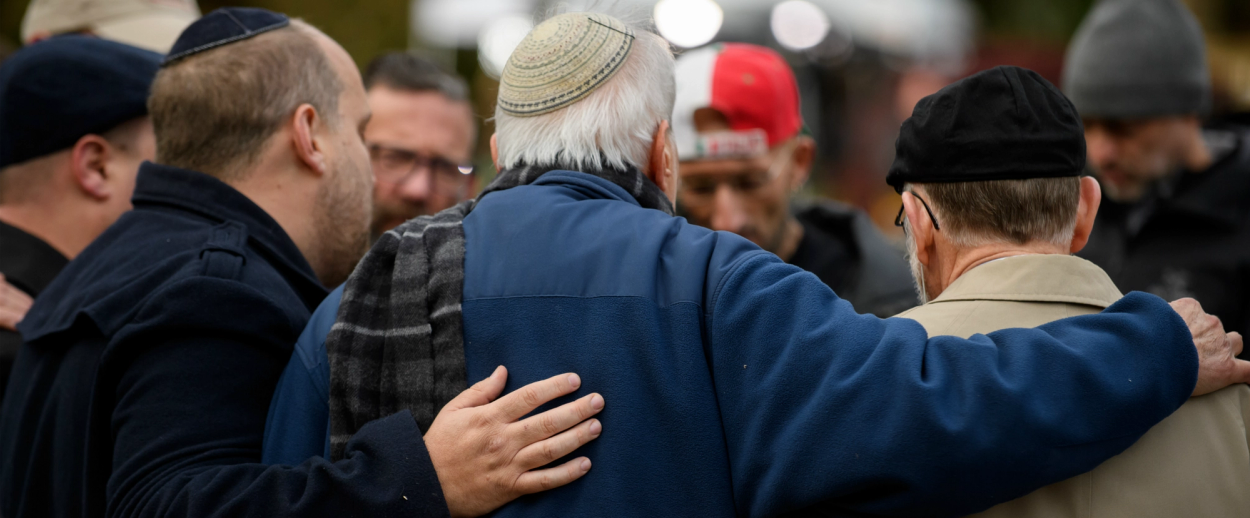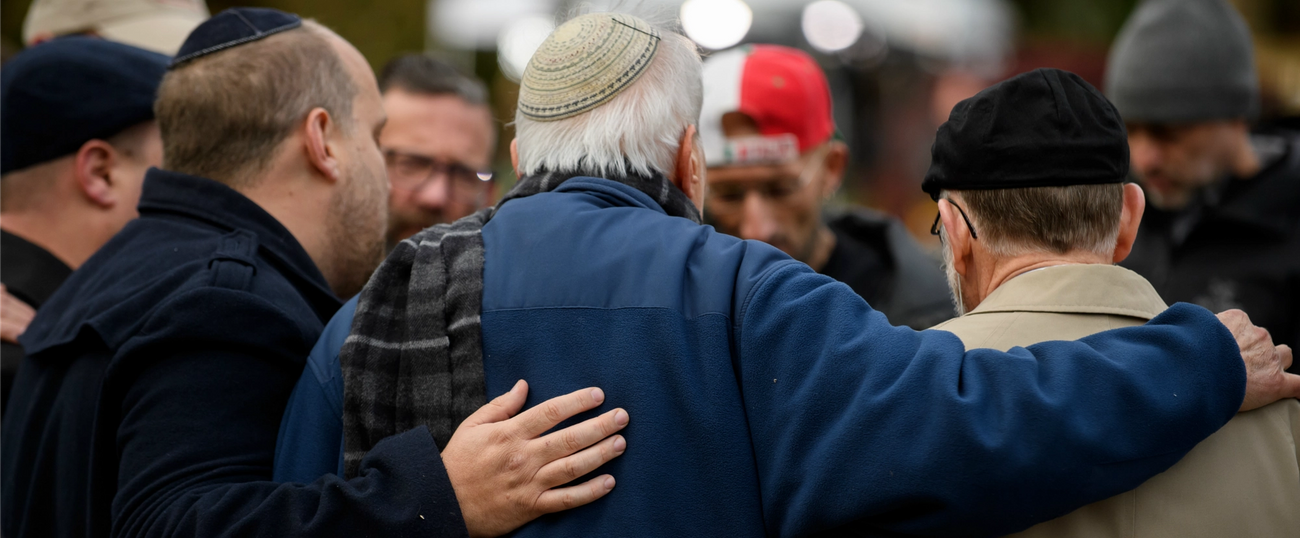Shiva in Pittsburgh
The shivas are packed, and like the funerals, people from every conceivable Jewish background are on hand




As I’ve been paying shiva calls to the families of the dead, one thing I’ve noticed is that people are hesitant to touch the food. Otherwise, in the midst of an unprecedented trauma—the aftermath of the worst mass murder of Jews in American history—shiva feels poignantly and defiantly normal, a ritual whose contours don’t really change based on how or why or when an individual dies. In Pittsburgh, as anywhere else, friends and families gather and pray and begin to inch towards whatever consolation might lie in the months or years ahead.
Shiva minyans are being held at the homes of the victims and their family members and at the Jewish Community Center, a 10-minute walk up the street from the Tree of Life. When the services get around to aleynu, often a triumphant uptempo conclusion to mincha or maariv, the daveners begin the prayer in an atonal chant. The gorgeous concluding melody arises almost against the mourners’ will.
The shivas are packed and like the funerals, people from every conceivable Jewish background are on hand along with the usual roster of rabbis and local Jewish community figures. But they’re often bunched in a corner of the room.
At one shiva, everyone stood during kaddish, an entire community rising in shared grief. At another, only family members stood, a reminder that beyond this attack’s significance to those outside Pittsburgh, these murders are personal and intimate tragedies. A visitor unconnected to one of the families or congregations develops a strong impulse against lingering too long.
The events of this week that make headlines are not at the forefront of people’s minds in Squirrel Hill, as the ripples of Saturday’s massacre continue to spread. The chevra kadisha has still only been allowed into one of the several sections of the Tree of Life where congregants were slaughtered. President Trump’s various utterances since the attack are distant background noise; even the president’s visit to the Tree of Life and the demonstration that followed seem to unfold in a different reality than the realm inhabited by funeral processions and Red Cross volunteers. Debates over the propriety of the conduct of various Israeli government officials don’t seem particularly important here.
Dani Dayan, Israel’s consul general in New York, addressed the shared funeral of Sylvan and Bernice Simon, who were murdered in the same chapel in which they had been married decades earlier. Speaking without notes, Dayan quoted a verse from Ecclesiastes in Hebrew about there being “a time to speak and a time to be silent.” “I think we are entitled this week to be silent and to bow our heads,” Dayan said. “The days in which we have to speak up … will come.”
Eric Lidji, the 36-year-old director of the Rauh Jewish History Program and Archives at the Senator John Heinz History Center, is in the unique and unenviable position of having to document the worst event in his community’s history as an academic historian. “We think in centuries-long time horizons at the archive,” he told me. We spoke after the Simon funerals, as mourners pulled out of parking lot of the red-brick Schugar Funeral Home and joined the procession to the National Cemetery of the Alleghenies, where Sylvan Simon and his wife will be buried in accordance with his status as a U.S. Navy veteran.
Lidji, who is the only full-time archivist of the city’s Jewish history, has attended as many of the services as possible to look for items of potential historical importance, as well as to mourn. He’s both an observer and a participant in the event he’s documenting, and he wears a red nametag around his neck.
“The challenge is figuring out what to collect and how to collect it,” Lidji explained. “Trying to get things in the moment so that they don’t get lost is something I’ve never done in this profession.” Oral histories are not a top priority right now (Pittsburgh has a Jewish oral history project dating back 50 years). There are more critical concerns, chief among them the sprawling, spontaneous memorial in front of the Tree of Life building.
“Yesterday we wanted to protect the memorial site from the rain but didn’t want to disturb it,” said Lidji. The accumulation of flowers, notes, sculptures, and a diversity of other objects is an “archival nightmare”: legally and communally ownerless, exposed to the elements, “constantly being added to and even subtracted from, for all we know.”
Lidji and others with the archive have been attending rallies and vigils around Pittsburgh this week, collecting signs, flyers, and prepared remarks from the events’ speakers. But the memorial poses an especially immediate challenge. They’re a repository of raw memory and emotion, and there’s already a sense that they’re in jeopardy. Lidji missed one funeral yesterday because of the urgent need to cover the memorial during an afternoon rainstorm.
Lidji’s other big archival challenge is a nightmare of an entirely different kind. There are only a small handful of community members who know what the interior of the Tree of Life now looks like, and Lidji is unsure when he’ll be allowed into the building to assess the archival significance of whatever is inside. There are almost certainly objects that can forever attest to Saturday’s massacre. While the witnesses of historical events inevitably die, Lidji noted, “we need documents and objects that can testify on their behalf.”
It will be important to identify and preserve historic materials that are currently in the Tree of Life building, which will eventually return to its function as a synagogue. “The events inside the synagogue are the moment,” said Lidji. “The rest is aftermath.”
Today marks the 30th anniversary of Pittsburgh’s Jewish archive. Lidji said that by the end of Thursday, the archive would be launching an online portal where users can submit materials about the vigils, memorials, and protests that took place around the world in the days after the massacre. History is even more fleeting than it seems. “It’s really a miracle anything survives,” Lidji said when reflecting on the condition of some of the printed matter in the archive’s collection. “Nothing is intrinsically permanent.”
By the time we finished speaking, the visitation line for the second-to-last of this week’s funerals—mourning the death of 65-year-old Richard Gottfried—extended to the corner of Centre Avenue and South Graham Street.
Armin Rosen is a staff writer for Tablet Magazine.